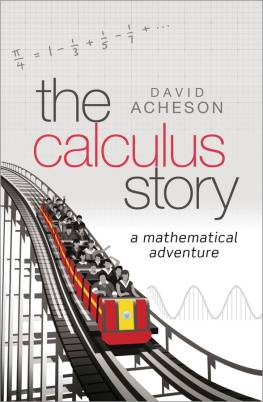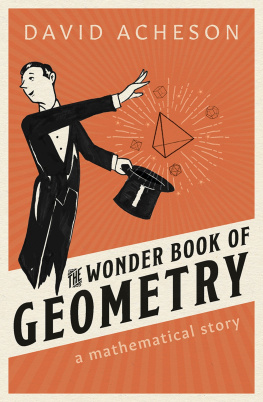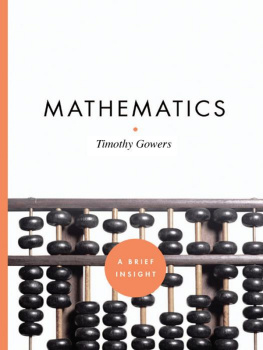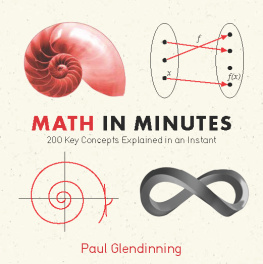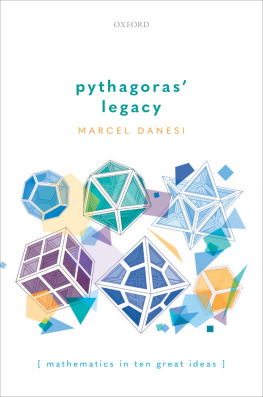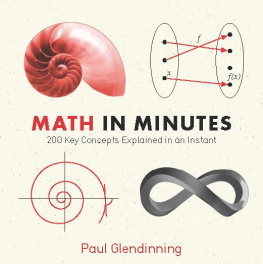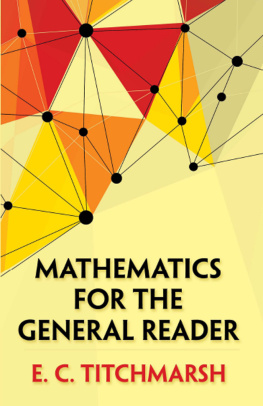Praise for the hardback
1089 and All That is an instant classic an inspiring little masterpiece.
Mathematical Association of America
Possibly the nicest maths book ever written.
Kjartan Poskitt, author of Murderous Maths
Every so often an author presents scientific ideas in a new way Starting from such minimalist material, David Acheson works his way up to chaos and catastrophe theory. Not a page passes without at least one intriguing insight Anyone who is baffled by mathematics should buy it. And all mathematicians should buy at least a dozen copies to hand out to people they meet at parties. My enthusiasm for it knows no bounds.
Ian Stewart in New Scientist
Who would like this book? Absolutely anyone. It is so nicely written, so charming, and so entertainingly lighthearted, that it is an absolute little gem.
PLUS online magazine, Cambridge
A lovely little book.
Simon Singh, author of Fermats Last Theorem
A little gem.
SIAM News
Great fun.
Mathematics Today
Delightful.
Mathematical Digest
Inspired.
Niall Ferguson, historian, in The Sunday Times
Highly accessible and entertaining.
The Mathematical Association
The tone of this little gem of a book is set by the allusion in its title to the W.C. Sellar and R.J. Yeatman classic 1066 and All That, and the outrageous Steve Bell cartoon on its cover The book is such an easy and entertaining read (my non-mathematical family members agree) There are few mathematicians who succeed in writing popular accounts of their craft without being superficial or condescending. With this book David Acheson has joined the best of them.
Times Higher Education Supplement
My ten-year-old daughter read the book with my guidance and loved it. Even mathematicians will find fresh perspectives on old themes in this playful and inventive book.
John Mighton in The Mathematical Intelligencer
The reader is left with a sense of the magic of mathematics An earlier reviewer has advised everyone to go out and buy a dozen copies, and I heartily agree, and hope that our embattled schoolteachers (and university lecturers!) take up the cry.
UK Nonlinear News
On the surface this book is another of those lets look at the funny things about numbers books. But no, this one was far more than that. It treated subjects briefly but in depth and breadth, linked them together, didnt make assumptions Truly inspiring, and a great read over a weekend.
Mathematics Teaching
Every teenage mathematician should have a copy.
Symmetry Plus Magazine
An ideal present for friends and relatives who are not mathematicians.
London Mathematical Society
Newsletter
1089 and All That
A Journey into Mathematics
David Acheson
Jesus College, Oxford


Great Clarendon Street, Oxford ox2 6dp
Oxford University Press is a department of the University of Oxford.
It furthers the Universitys objective of excellence in research, scholarship,
and education by publishing worldwide in
Oxford New York
Auckland Bangkok Buenos Aires Cape Town Chennai
Dar es Salaam Delhi Hong Kong Istanbul Karachi Kolkata
Kuala Lumpur Madrid Melbourne Mexico City Mumbai Nairobi
So Paulo Shanghai Taipei Tokyo Toronto
with an associated company in Berlin
Oxford is a registered trade mark of Oxford University Press
in the UK and in certain other countries
Published in the United States
by Oxford University Press Inc., New York
David Acheson, 2002
The moral rights of the author have been asserted
Database right Oxford University Press (maker)
First published 2002
First published in paperback 2010
All rights reserved. No part of this publication may be reproduced,
stored in a retrieval system, or transmitted, in any form or by any means,
without the prior permission in writing of Oxford University Press,
or as expressly permitted by law, or under terms agreed with the appropriate
reprographics rights organization. Enquiries concerning reproduction
outside the scope of the above should be sent to the Rights Department,
Oxford University Press, at the address above.
You must not circulate this book in any other binding or cover
and you must impose this same condition on any acquirer
A catalogue record for this book is available from the British Library
Library of Congress Cataloging in Publication Data
(Data available)
ISBN 978-0-19-851623-1 (Hbk)
ISBN 978-0-19-959002-5 (Pbk)
2 4 6 8 10 9 7 5 3 1
Typeset by Footnote Graphics
Printed in Great Britain
on acid-free paper by Biddles Ltd, Guildford & Kings Lynn
Contents

CHAPTER ONE
1089 and All That
Think of a three-figure number.
Any three-figure number will do, so long as the first and last figures differ by 2 or more.
Now reverse it, and subtract the smaller number from the larger. So, for example,
782 287 = 495.
Finally, reverse the new three-figure number, and add:
495 + 594 = 1089.
At the end of this procedure, then, we have a final answer of 1089, though we have to expect, surely, that this final answer will depend on which three-figure number we start with.
But it doesnt.
The final answer always turns out to be 1089.

As I remember, the 1089 trick was the first piece of mathematics that really impressed me, and I came across it at the age of ten, in the I-SPY Annual for 1956.

This was a book for children, published by a well-known British newspaper of the time, and it contained a mixture of adventure stories and more educational articles with titles like Pond Life.
But my favourite bit, by a long way, was


There were other conjuring tricks as well, including The Vanishing Glass of Water and Reading the Mind, but somehow it was 1089 that really caught my attention.
It was the element of mystery and surprise, I think, that put this result into a different league from some of the work we were doing in school.

Now, Im not saying that I didnt enjoy sums, and other bits of elementary mathematics, for I most certainly did. But if I tell you, for instance, that a typical homework problem at the time went something like this:


